Car culture and automobility in Anne Arundel County: Part 1 | A cycletrack on Main Street in Annapolis
I started using the term "car culture and automobility" more than a decade ago after seeing the terms used separately. I just found out that the phrase "systems of automobility" was coined by John Urry, but I don't know if he was "the first."
It was at a conference in Annapolis, Maryland in 2005 at the Preservation Maryland conference, on a walking tour led by the city's chief planner, when I got more nuanced insight into reflexive resident opposition to new development on the grounds of increased traffic.
In a place like Annapolis, which does have some bicyclists and a small bus-based transit system, virtually every trip to a destination is performed in an automobile.
So you can get a sense that opposition to new projects over traffic isn't necessarily reflexive, but a recognition of reality.
By contrast, in a walkable-bikeable-transit city, a majority of the trips, depending on how proximate the new development is to transit and/or its WalkScore or BikeScore, a majority of the trips to and from the site are likely to be conducted by sustainable modes.
Opposition to existing light rail service. I still haven't finished another post about how residents in Anne Arundel County, Maryland, close to the Linthicum light rail station, have been calling for its closure because they don't use it much and they think the people who do are likely to be criminals ("Fight over light rail in Anne Arundel takes to the streets in rallies," Annapolis Capital-Gazette).
Controversy, mostly against, a bicycle lane on Main Street in Annapolis. Separately, in Annapolis, the county seat, some residents and business owners are fighting the insertion of a cycle track on Main Street, saying it makes it harder to park, hurts business, etc.
The mayor has initiated a temporary bike lane on the street, which will be up through most of October.
-- "Coverage and commentary: The Annapolis bike lane program," Capital-Gazette
Obviously, I disagree, but it's true that the likelihood of a high number of bike riders there, at least currently, isn't that high. And the average resident is likely to be wed to the automobile and has a difficult time imagining anyone getting around by any mode other than the car.
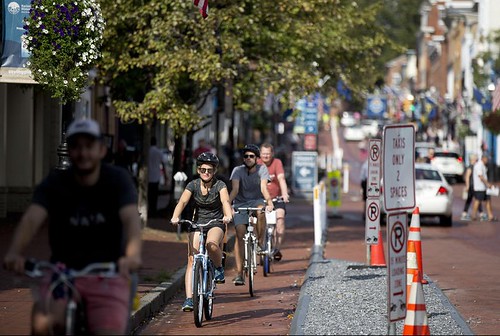
Photo: Jen Rynda / Baltimore Sun Media Group. Bikers make their way down Main Street during Annapolis Bike Day bike ride in Annapolis on Saturday, September 22, 2018.
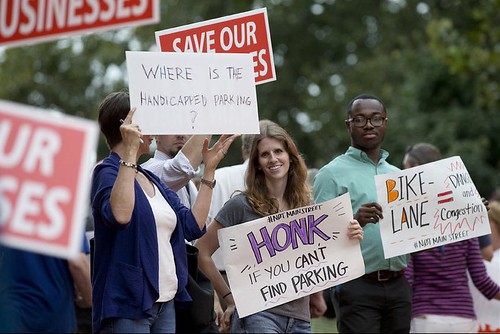
Jen Rynda / BSMG. Protestors Erin George of Centreville and Yaw Obeng Sarkodie, right, of Beltsville gather on Main Street before the Lighted Bike Parade in Annapolis on Friday, September 21, 2018.
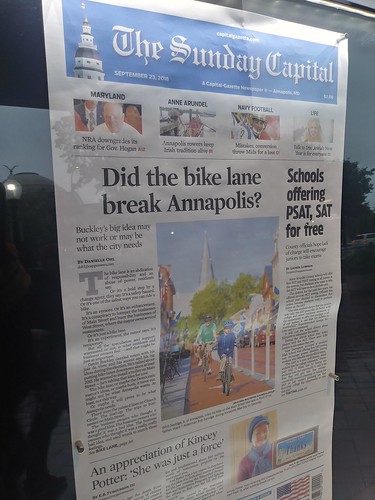 Sunday's front page of the Capital featured this article, "Did Buckley's bike lane break Annapolis."
Sunday's front page of the Capital featured this article, "Did Buckley's bike lane break Annapolis."But as I wrote last week ("Parking isn't "the third rail" of local politics, it's the car and automobility") the reality is that Annapolis has thousands of parking spaces in the vicinity in public and private parking garages and lots, and giving up a few parking spots on the street in favor of supporting sustainable modes, urban design, and placemaking is a plus.
But people, imprinted with the automobility paradigm, disagree, such as this letter writer:
Move to EuropeGetting elected officials and stakeholders on board with innovation. I argue that for the best results in trying to adopt new sustainable mobility infrastructure, it's a waste of breath to discuss examples from Europe. People can't relate.
For those of us who work in downtown Annapolis, the new bike path on Main Street is a bad idea, to say the least.
Since the implementation, I haven't seen one biker use the path. Parking downtown is a headache most of the time and to take away 36 parking spaces on Main Street is abominable.
As a Realtor at Long & Foster, I can tell you that we get a lot of walk-in traffic because people love Annapolis and want to move here. This bike path won't generate more business for the shops or restaurants. If anything it will hurt these businesses.
Has Mayor Gavin Buckley given any thought about the problems we incur when the boat shows are here or when the legislature is in session? If I wanted a European atmosphere, I would move to Europe. What's next tearing down old Historic buildings?
MARY CLARE HOLDER
Annapolis
They even have a hard time with other examples elsewhere across the continent. Montreal, Portland, Minneapolis, Boulder, etc. seem too distant and irrelevant and they can always come up with reasons about why those examples aren't relevant "to my city."
Elected officials can usually accept similar examples from elsewhere in the state although there remains the urban-center city-suburban/exurban divide. That's the basis of the concept of "positive deviance" as a way to move change forward (see links in this entry, "I get tired of all the talk about rewarding "failure" because it shows people are trying, and won't be penalized for it" ) in uncongenial environments.
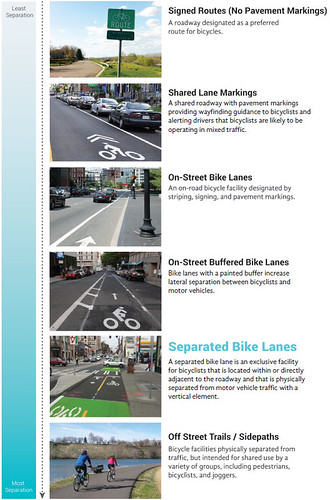 That's why I argue that state departments of transportation need to focus on the installation and demonstration of infrastructure in highly visible locations in the state, and use that as an example with jurisdictions across the state.
That's why I argue that state departments of transportation need to focus on the installation and demonstration of infrastructure in highly visible locations in the state, and use that as an example with jurisdictions across the state.Producing graphics like this, but with state-specific examples, would be a good step forward. (Image People for Bikes.)
I thought I convinced a top Maryland transportation planner on this in 2010/2011, but I guess not because a few years later when I interviewed for a job they lacked the courtesy to tell me I didn't get it, I just never heard from them again.
(Although a paper I wrote influenced their decision to incorporate bicycle infrastructure in parts of the Purple Line routing where it doesn't already exist.)
In talking, I suggested that Wisconsin Avenue-Rockville Pike in Montgomery County would be a perfect example. If you can make it work there, no one would be able to talk against such infrastructure. (See the discussion here, "PL #5: Creating a Silver Spring "Sustainable Mobility District": Part 1: Setting the stage.")
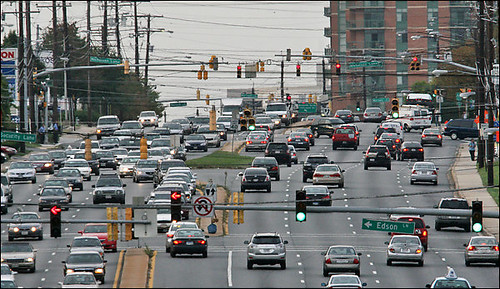
Rockville Pike. Washington Post photo.
Maybe Annapolis could serve as that sustainable mobility demonstration site for Maryland? But now that I think about it, maybe Annapolis would be better, because so many of the state's elected officials and stakeholders go to Annapolis to meet with legislators and government officials. When there they would see such infrastructure with their own eyes, and consider adopting it in their hometowns.
This would be comparable to the impact of DC's Capital Bikeshare on local elected officials across the country. They come to DC, see it in operation, and go back home primed with the idea of installing similar systems.
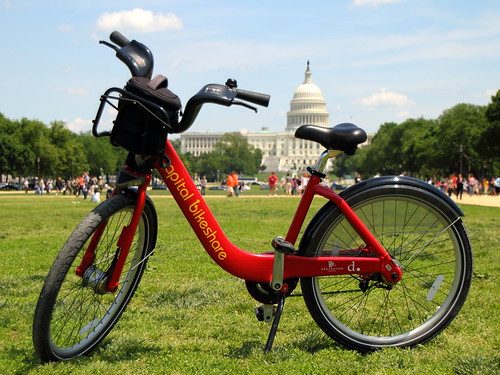
In the meantime, Annapolis Mayor Gavin Buckley is doing his best to move the project forward. (It reminds me some of the example of the now former mayor of Columbia, Missouri. See "A Free-Wheeling City," Parade Magazine; "The age of Hindman," Columbia Daily Tribune.)
From the "Break Annapolis" article:
Sandwiched between protests organized by the angriest of the anti-bike lane community members Friday night and Saturday afternoon, Buckley rallied about 100 bikers Saturday morning for a Bike Day ride down Main Street.
Before the ride, he gathered bikers on West Street for a rallying cry.
Mayor Gavin Buckley leads a bike ride from Whitmore Park to Susan Campbell Park followed by a Children's Bike Rodeo to reinforce safety habits and teach basic biking skills in Annapolis on Saturday, Sept. 22, 2018. (Staff Photos by Jen Rynda / BSMG)
“Cars own our town,” he told the crowd. “We have a historic town, and cars own the best real estate. They own the City Dock, they own both sides of Main Street.
“I don’t think that’s right, but that’s just my opinion. We’re all entitled to our opinion. But when we look around the country, our cities are investing in bike infrastructure and putting people before cars — other cities that we go to and say, ‘How amazing is this?’ ”
He joked about protesters and bike lane-opposers, thanking riders for their bravery.
“I’m not sure what’s going to happen on the other side, if it will be torches and pitchforks. We’ll just kill ‘em with kindness and go down to City Dock to enjoy this city the way it’s meant to be enjoyed.”
=====
From ""The age of Hindman," written on the retirement of Darwin Hindman as Mayor of Columbia, Missouri:
In his 15 years of active service, Hindman has taken many bold stands, some infuriating to certain people. His undying promotion of parks, trails and alternative transportation is an example. But without his pushiness, consider our bereavement.Note that "Ted Jones" mentioned above was "Edward Jones" of the investment firm Edward Jones...
Hindman might fairly be remembered as the father of the Katy Trail.
In an effort to exploit the new opportunity provided by Congress with passage of the so-called Rails to Trails Act, the newly elected mayor of Columbia planned a trip to lobby then-Gov. John Ashcroft for support of a plan to convert abandoned railroad rights of way into a public, cross-state trail that would become one of Missouri’s most popular state parks.
Hindman says Ashcroft was for the idea but recognized the strong opposition it would face, mainly from rural interests. The mayor figured his entreaty would have more weight if he took along a well-known person from the business community. He knew that the president of an investment firm bearing his family name was interested in public recreation, so he asked Ted Jones. With typical lack of hesitation Jones quickly agreed, and the two set off for Jefferson City.
Gov. Ashcroft thanked the two solicitors for their civic-minded interest but reminded them the state had no money for such a project, at which time Jones quickly said he would pay for restrooms all along the trail, a kickoff gesture typical of Jones’ leadership style.
With strong support from Ed Stegner of the Conservation Federation of Missouri, the fight began in the General Assembly. Not much state startup money was needed -- a few hundred thousand dollars -- but getting the state behind the transition of the rail rights of way required a formidable fight over the dead bodies of the Farm Bureau and other conservative rural interests. Finally, by one vote as Hindman recalls, the legislature approved the deal, and the battle over implementation was launched, peppered with court battles to resolve issues regarding legal authority and ownership of the land. ...
The point of this story is to describe Darry Hindman’s style. When something is worth promoting, he is off his duff and on the road, going for it. Without him and cohort Jones, we might not have a cross-state trail. Certainly, we would not have one as comprehensive or quickly developed.
Since then, Hindman and Columbia have become known nationally for development of trails and the federally funded GetAbout Columbia project to enhance nonmotorized transportation.
The mayor put himself in the perfect position to catch flak for every new stripe on a city street or a redirected lane at a busy intersection. Amid this flurry of slings and arrows he has remained receptive and even ebullient, testing the program’s progress on his own bicycle, dedicated to making it work rather than fighting with detractors. Another “leader” would have hunkered down in thoughtful contemplation about bike and trail ideas, avoiding trouble and accomplishing nothing.
Labels: bicycle and pedestrian planning, car culture and automobility, change-innovation-transformation, leadership-vision, transportation planning, urban design/placemaking




2 Comments:
This member of Annapolis' Environmental Commission makes good points about the need for public consultation to do projects like this, although she isn't in favor of a bike lane, but of other environmental measures.
https://www.capitalgazette.com/opinion/columns/ac-ce-column-buccheister-20181106-story.html
Alfazal Engineering providing services for Cable tray, Tower tray, and other sheet metal work at very economical prices with the best delivery time all over Pakistan. tower trays for the refinery. Cable Tray street lighting poles manufacturer in Pakistan by Al-Fazal Engineering Perforated Cable Tray Made of Sheets With Perforation on the based. Cable Gland, Cable tray distributor in Pakistan. We are available for your support 24/7 and 100% guarantee for quality. We never compromise in the quality of the cable tray and other products.
Cable tray in Pakistan
Post a Comment
<< Home